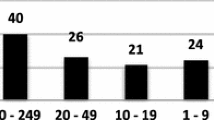Abstract
One of the most intractable problems in software is getting engineers to consistently use effective methods. The Software Engineering Institute (SEI) has worked on this problem for a number of years and has developed effective methods for addressing it. This paper describes these methods and shows what they have accomplished with several hundred students and working engineers. After first describing the problem of changing engineers' practices, the paper discusses the logic engineers typically follow in deciding what methods to use. Next is a description of the Personal Software Process (PSP) and the Team Software Process (TSP). Finally, the implications of SEI's experiences with the PSP and TSP are described, with particular emphasis on software engineering and computer science education.
Similar content being viewed by others
References
Ferguson, P., W.S. Humphrey, S. Khajenoori, S. Macke, and A. Matvya (1997), “Introducing the Personal Software Process: Three Industry Case Studies,” IEEE Computer 30, 5, 24–31.
Hayes, W. (1997), “The Personal Software Process: An Empirical Study of the Impact of PSP on Individual Engineers,” Technical Report CMU/SEI-97-TR-001.
Hilburn, T.B. and J. Over (1997), “Lectures and Exercises,” In PSP Faculty Workshop, Software Engineering Institute and Embry-Riddle Aeronautical University, Daytona Beach, Florida, June 23–27.
Humphrey, W.S. (1989), Managing the Software Process, Addison-Wesley, Reading, MA.
Humphrey, W.S. (1995), A Discipline for Software Engineering, Addison-Wesley, Reading, MA.
Humphrey, W.S. (1996), “Using a Defined and Measured Personal Software Process,” IEEE Software, May.
Humphrey, W.S. (1997), Introduction to the Personal Software Process, Addison-Wesley, Reading, MA.
Humphrey, W.S. and J. Over (in press), Introduction to the Team Software Process, Addison-Wesley, Reading, MA.
Kaplan, C., R. Clark, and V. Tang (1994), Secrets of Software Quality, 40 Innovations from IBM, McGraw-Hill, Inc., New York. On pages 173–176, the authors discuss this issue and give an example of a large product where the correlation between development test and customer-reported defects was 0.964 with a significance of better than 0.001.
Paulk, M.C. et al. (1995), The Capability Maturity Model: Guidelines for Improving the Software Process, Addison-Wesley, Reading, MA.
Author information
Authors and Affiliations
Rights and permissions
About this article
Cite this article
Humphrey, W.S. Why don't they practice what we preach?. Annals of Software Engineering 6, 201–222 (1998). https://doi.org/10.1023/A:1018997029222
Issue Date:
DOI: https://doi.org/10.1023/A:1018997029222




